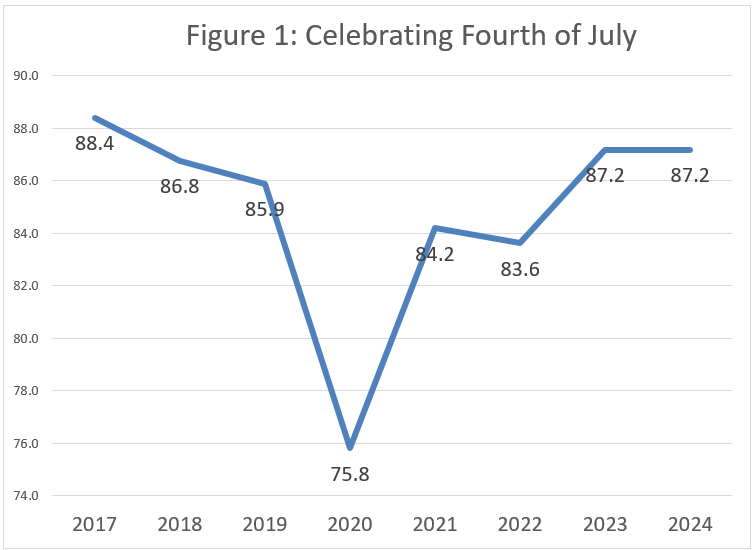Executive Summary:
The Fourth of July is the second most popular American holiday, following only Christmas.
Key highlights include:
- 87.2% of respondents celebrate the Fourth of July, the same as 2023.
- Over 68% of respondents have noticed higher prices, particularly in beverages and food.
- Celebrators are more likely to be male, married, have children, and belong to younger generations (Gen-Z and Millennials).
- July Fourth celebrators report higher overall happiness, particularly in their love life, work life, and government satisfaction.
Retail Trends, Spending, and the Fourth of July Celebratory Patterns
By Dr. Martin Block, Professor Emeritus, Northwestern University, Retail Analytics Council
The Fourth of July is the second most popular American holiday after Christmas. Celebrating the Fourth of July is among the topics covered by Prosper Insights & Analytics (www.ProsperInsights.com) in the monthly online surveys that collect data about annual events and related market behavior. Celebrating the Fourth of July was asked in the June 2024 survey (n=8,952). In response to the question, “How do you plan to celebrate July 4th this year?” Of the total, 12.8% said they don’t celebrate the Fourth of July, leaving 87.2% who do. As shown in Table 1. The celebration rate is unchanged from 2023. Also, June is the first month when shopping for back to school or college is asked, which is indicated by 33.9%.
Table 1. Seasonal Holiday Participation.
| Percent | |
| Christmas | 93.4 |
| 4th of July | 87.2 |
| Mother’s Day | 84.2 |
| Celebrate Easter | 80.7 |
| Super Bowl | 76.9 |
| Father’s Day | 75.4 |
| Halloween | 73.1 |
| St. Patrick’s Day | 61.9 |
| Valentines Day | 52.0 |
| Graduation | 33.6 |
Recent Fourth of July Celebration History
The July Fourth celebration rate has remained relatively flat, especially for the last eight years, as shown in Figure 1. The rate dropped in 2020, no doubt related to COVID-19.

Celebrating July Fourth is more complicated because it can involve different activities. Table 2 shows that a cookout is the most common activity, at 66.3%, followed by fireworks at 44.2%. The base is the total sample. Cookouts show a small annual increase of 0.29% over the last eight years. Everything else remains almost perfectly flat. However, cookouts increased almost a percent over 2023, which was 65.4%. Fireworks also increased by two percentage points in 2023.
Table 2. July Fourth Celebration Activities.
| Percent | AGR | |
| Cookout/Barbecue/Picnic | 66.3 | 0.29 |
| Fireworks/Community Celebration | 44.2 | 0.00 |
| Attending a parade | 12.9 | -0.05 |
| Travel/Vacation | 12.5 | 0.00 |
| Will Celebrate | 87.2 | -0.06 |
The overall average planned spending amount is $87.53. This compares to the $184 reported for Father’s Day last month and the $254 reported for Mother’s Day two months ago. Spending growth has been steady over the last eight years, with an average annual increase of $2.85.
As shown in Table 3, a lot of patriotic merchandise is already owned. The American flag is the leading item, followed by apparel and decorations. Almost a third (30.9%) say they plan to purchase additional patriotic merchandise within 30 days. An additional 31.6% say they are unsure, and 37.6% say they are not planning any purchases.
Table 3. Patriotic Items Already Owned.
| Percent | |
| American flag | 61.0 |
| Apparel (T-shirt, hat, etc.) | 52.0 |
| Decorations | 41.9 |
| Music | 25.5 |
| Bumper sticker or car decal | 10.4 |
| Other | 2.8 |
| Do not own patriotic merchandise | 14.8 |
Higher prices are becoming an issue. Almost two-thirds say they notice higher prices, as shown in Table 4. The items that have been noticed are food and beverages, which are frequently shopped for and are shown in Table 5. Even higher prices for fireworks have been noticed by 40.8%.
Table 4. Notice Higher Prices.
| Percent | |
| Yes, much higher | 27.5 |
| Yes, somewhat higher | 39.5 |
| About the same | 30.5 |
| No, somewhat lower | 1.6 |
| No, much lower | 1.0 |
Table 5. Which Items Noticed Higher Prices
| Percent | |
| Food | 80.8 |
| Beverages | 68.6 |
| Decorations | 53.0 |
| Patriotic apparel | 47.8 |
| Fireworks | 40.8 |
Cookouts, as shown in Table 2, require a list of items, as shown in Table 6. Hamburger leads the list of items at 82.8%. Interestingly, plant-based meat alternatives are only at 15.1%.
Table 6. Purchase for Cookout.
| Percent | |
| Hamburger | 82.8 |
| Hotdogs/pork or beef brats | 75.2 |
| Chicken | 50.8 |
| Vegetables | 43.1 |
| Plant-based meat alternatives | 15.1 |
| Fish | 11.3 |
| Other | 9.4 |
Although over half (56.6%) say they are likely to purchase plant-based items as shown in Table 7. The reasons given are the health and dietary restrictions of guests. Higher prices are also a reason for about half (49.35).
Table 7. Purchase Plant-Based Alternatives and Reasons
| Percent | |
| Very likely | 26.3 |
| Somewhat likely | 30.3 |
| Somewhat unlikely | 18.7 |
| Very unlikely | 24.6 |
| Reasons | |
| Health | 53.0 |
| Higher prices | 49.3 |
| Guests with dietary restrictions | 34.3 |
| Climate change | 18.5 |
| Other (please specify) | 5.0 |
Recycled materials for disposables are a strong reason for their purchase for the celebration. This includes recyclables, which are made from recyclable material and are compostable.
Table 8. When Buying Disposables, What Do You Look For?
| Percent | |
| Recyclable | 53.6 |
| Made from recycled materials | 41.5 |
| Compostable | 25.6 |
| Do not purchase these for my celebrations | 20.0 |
July Fourth Celebrators
A description of the July Fourth celebrators is shown in Table 9. The comparison is made according to their planned celebration in 2024—about 87.2% report planning to celebrate. The 12.8% that don’t celebrate was reported earlier comprise the “Don’t” column. To facilitate comparison, an index is computed comparing the percentage of those who don’t celebrate to the total. As shown in Table 9, celebrators are more likely to be male. Those who are married, have children, and are either Gen-Z or Millennial are more likely to celebrate the Fourth of July. Those divorced or widowed and a Boomer or Senior are less likely to celebrate. Celebrators also have higher incomes.
Table 9. Celebrator Demographics.
| Don’t | Celebrate | Total | Don’t Index | |
| Male | 39.5 | 47.0 | 46.0 | 85.9 |
| Female | 60.5 | 53.0 | 54.0 | 112.0 |
| Married | 29.2 | 38.2 | 37.1 | 78.7 |
| Living with an Unmarried Partner | 6.7 | 9.9 | 9.5 | 70.5 |
| Divorced or separated | 16.2 | 11.4 | 12.0 | 135.0 |
| Widowed | 8.6 | 4.3 | 4.8 | 179.2 |
| Single, never married | 36.9 | 31.8 | 32.4 | 113.9 |
| Have Children | 15.3 | 36.8 | 34.1 | 44.9 |
| Income | 51.3 | 61.7 | 60.4 | 84.9 |
| Gen-Z | 11.6 | 17.6 | 16.8 | 69.0 |
| Millennials | 18.5 | 29.8 | 28.4 | 65.1 |
| Gen-X | 24.0 | 27.0 | 26.7 | 89.9 |
| Boomers | 40.3 | 23.7 | 25.7 | 156.8 |
| Seniors | 5.6 | 1.9 | 2.4 | 233.3 |
| Average Age | 54.5 | 46.9 | 47.8 | 114.0 |
| African American | 13.5 | 14.0 | 13.9 | 97.1 |
| Asian | 4.2 | 3.7 | 3.8 | 110.5 |
| Multi-Racial | 1.3 | 1.6 | 1.6 | 81.3 |
| Native American | 1.1 | 1.2 | 1.2 | 91.7 |
| White | 67.5 | 61.0 | 61.8 | 109.2 |
| Hispanic | 9.4 | 14.2 | 13.6 | 69.1 |
| Rural | 23.7 | 25.5 | 25.2 | 94.0 |
| Urban | 41.1 | 37.9 | 38.3 | 107.3 |
| Suburban | 34.3 | 35.9 | 35.7 | 96.1 |
Happiness
Respondents are asked to rate their overall happiness across ten categories on a five-point scale. Table 10 shows the proportion of the combination of happy and totally happy. The unmistakable conclusion is that those who plan to celebrate the Fourth of July Day are happier than those who do not, as shown in the composite average. The biggest differences are in love life, work life, and government, as seen among previous Easter, Mother’s Day, and Father’s Day celebrators in recent months.
Table 10. Happiness by Fourth of July Celebration.
| Don’t | Celebrate | Total | Don’t Index | |
| Health | 40.9 | 55.9 | 54.1 | 75.6 |
| Family | 52.5 | 65.2 | 63.6 | 82.5 |
| Friends | 51.3 | 62.3 | 60.9 | 84.2 |
| Love Life | 36.3 | 52.7 | 50.7 | 71.7 |
| Home | 53.8 | 63.1 | 61.9 | 86.8 |
| Religion | 45.4 | 57.2 | 55.7 | 81.4 |
| Work Life | 28.1 | 43.6 | 41.6 | 67.5 |
| House | 50.3 | 59.8 | 58.7 | 85.7 |
| Neighborhood | 48.9 | 58.6 | 57.4 | 85.3 |
| Government | 16.9 | 24.9 | 23.9 | 70.8 |
| Composite | 42.4 | 54.3 | 52.8 | 80.3 |
Summary
The Fourth of July Father’s Day ranks only behind Christmas. Celebrating the day has remained almost flat in the last eight years. Spending, however, is up, no doubt, because of the emphasis on a cookout and food. The presence of children, age, marital status, and income are the strongest predictors of planning to celebrate. Celebrators are also happier than those who don’t plan to celebrate.
